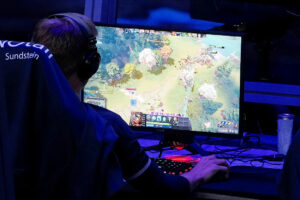By Genie Yuan
GAMING today is far from child’s play. The sophistication of games and the professionalization of gaming through e-sports have pushed the industry into a lucrative growth driver that could be worth $300 billion by 2028.
With over 43 million active gamers, the Philippine gaming industry posted a record $7.16 billion in gross revenue last year. These figures stem from the fact that the Philippines has a distinct mobile-first gaming culture, with a strong e-sports scene officially sanctioned by the Games and Amusements Board.
The Department of Science and Technology is also connecting with active local gamers through partnerships and collaborations. These initiatives demonstrate an understanding that gaming can continue to be a significant national economic contributor.
Propelled by the statewide rollout of 5G and greater aspirations for digital infrastructure, this growth will coincide with a wider digital transformation in Philippine society. In fact, projections by MarkNtel estimate that revenue in the local cloud gaming sector could reach $16.57 million by 2030, quadrupling from its current level.
However, with rapidly rising demand, the onus is on developers and studios to deliver smooth, scalable, and internationally competitive gaming experiences.
TRANSFORMING THE PLAYER EXPERIENCEArtificial intelligence (AI) is often touted as a force multiplier for efficiency and performance. Imagine national e-sports competitions such as the Mobile Legends Professional League enhanced by AI-powered matchmaking and interactive content, or mobile studios providing cloud gaming at scale with tailored experiences.
From designing intelligent opponent behaviors to procedurally generating entire environments, real-time AI deployments have already started to revolutionize game design. Now, matchmaking algorithms are able to swiftly put together balanced teams, assess players’ skill levels, and forecast user satisfaction with particular game modes.
In a matter of seconds, fraud detection systems can spot unusual login patterns or win rates. Generative AI even opens up new kinds of storytelling, where plots can react in real time to each player’s decisions, producing experiences tailored to a diverse range of preferred play styles.
Generative models also lessen the need for human scriptwriters by producing realistic voice exchanges and infinite questlines. At the same time, retrieval-augmented generation (RAG) can assist in-game AI to improve and maintain contextually relevant responses.
These advancements in gaming experience are completely achievable and far less intimidating than they appear but will depend on whether studios in the Philippines have the data architecture in place to realize them.
DELIVERING WHAT THE CUSTOMERS DEMANDGaming has evolved markedly. Where games were once just about running, jumping, or shooting, today they blend social engagement, user-generated content, branded partnerships, and even real-world shopping — sometimes all in a single session. Players switch between devices and network connections, but they will not compromise on consistent performance and real-time personalization.
Users’ faith in a platform can quickly erode if scheduled server maintenance exercises or unexpected data refreshes get in the way of their gaming experience. It’s not surprising, then, that Couchbase finds many studios have day-28 retention rates of as low as 6.5%.
In the Philippines, the problem is exacerbated by unpredictable internet performance. Despite median speeds of 58.37 Mbps for mobile and 103.71 Mbps for fixed connections, connectivity remains a key challenge. To meet these expectations, studios and developers must plan for extreme performance, stable uptime, and instant responsiveness.
THE NEXT WAVE OF GAMINGThere’s a golden opportunity for developers and studios to leverage AI to personalize in-game content and manage player trust and fairness in real time.
These cutting-edge methods, when combined with a memory-first, high-performance database that employs event-driven triggers and quick data storage, give developers the ability to quickly adapt to environments. Whether that means adding a surprise event for a holiday promotion or modifying item drops for a team with limited resources, developers have the agility to retain gamers’ attention.
It’s how Lotum, a Germany-based global gaming powerhouse with more than 800 million downloads worldwide, was able to guarantee seamless performance for its users even when dealing with unreliable network connectivity. Lotum’s games are available across Android, iOS, and multiple social network platforms, so keeping gamers engaged across multiple devices was of utmost importance.
The studio was able to pull this off with the help of a cloud-based NoSQL Database-as-a-Service, giving them speed, flexibility, and real-time analytics while minimizing administration efforts.
This allowed players to easily switch devices and maintain their progress, with the system automatically syncing data once a connection is restored. It’s easy to see how this can work within the Philippines’ mobile-first player base — and how developers and studios can capitalize on this opportunity.
POWERING NEXT-GEN GAMINGFilipino studios aiming to gain a first-mover advantage must first look inward and ask a critical question: is their backend built to deliver low latency, sync seamlessly across devices, scale during sudden traffic surges, integrate AI, and uphold responsible gaming standards?
In a market that is competitive, mobile-first, and increasingly regulated, removing infrastructure burdens is the key to unlocking creativity. By relying on a unified platform designed for performance at scale, local developers can focus on crafting unforgettable, locally immersive experiences while ensuring their games meet global expectations for speed, fairness, and engagement. The opportunity to lead starts with building on a stronger data foundation.
Genie Yuan is the regional vice-president, APAC Japan at Couchbase.
